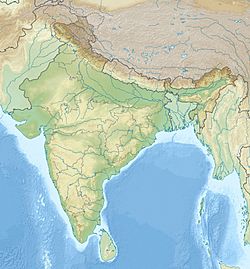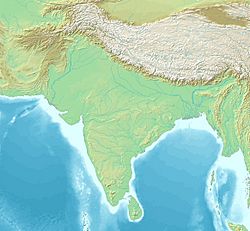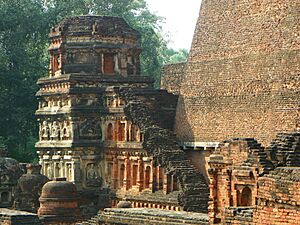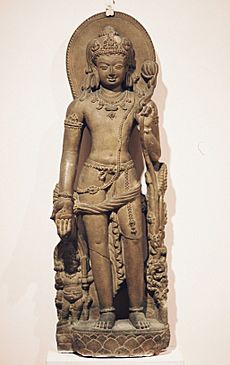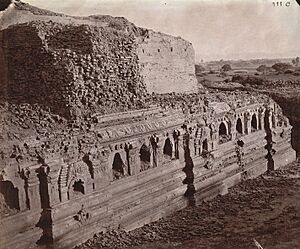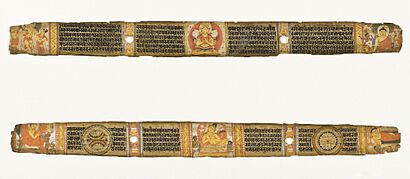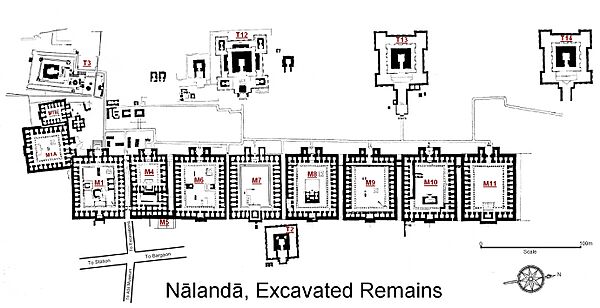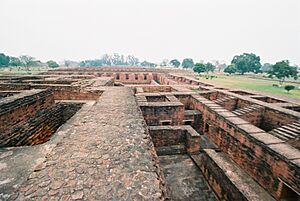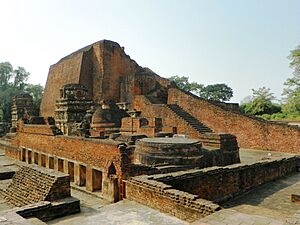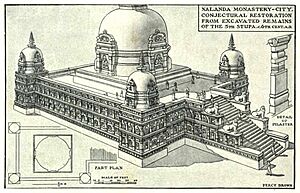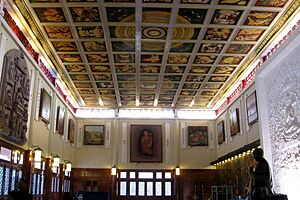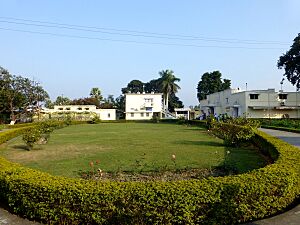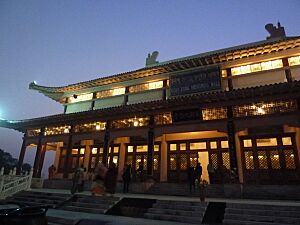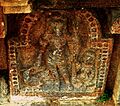Nalanda mahavihara facts for kids
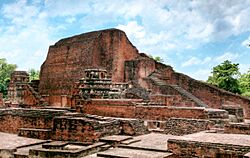
The ruins of Nalanda Mahavihara
|
|
| Location | Nalanda district, Bihar, India |
|---|---|
| Region | Magadha |
| Coordinates | 25°08′12″N 85°26′38″E / 25.13667°N 85.44389°E |
| Type | Centre of learning, mahavihara |
| Length | 800 ft (240 m) |
| Width | 1,600 ft (490 m) |
| Area | 12 ha (30 acres) |
| History | |
| Builder | King Kumaragupta I |
| Founded | 5th century CE |
| Abandoned | Around 1400 CE |
| Events | Ransacked by Muhammad Bakhtiyar Khilji in c. 1200 CE |
| Site notes | |
| Excavation dates | 1915–1937, 1974–1982 |
| Archaeologists | David B. Spooner, Hiranand Sastri, Palak Shah, J. A. Page, M. Kuraishi, G. C. Chandra, N. Nazim, Amalananda Ghosh |
| Condition | In ruins |
| Ownership | Government of India |
| Management | Archaeological Survey of India |
| Public access | Yes |
| ASI No. N-BR-43 | |
| UNESCO World Heritage Site | |
| Official name | Archaeological Site of Nalanda Mahavihara at Nalanda, Bihar |
| Criteria | Cultural: iv, vi |
| Inscription | 2016 (40th Session) |
| Area | 23 ha |
| Buffer zone | 57.88 ha |
Nalanda was a famous Buddhist mahavihara (which means "great monastery" or "great learning center") in ancient India. It was located in what is now Bihar, in eastern India. Many people think it was one of the best learning centers in the ancient world.
Nalanda was near the city of Rajagriha (today called Rajgir), about 90 kilometers (56 miles) southeast of Pataliputra (now Patna). It operated from about 427 CE until the 13th century. Nalanda helped a lot with art and education during the 5th and 6th centuries. This time is often called the "Golden Age of India" by historians.
Emperor Kumaragupta I of the Gupta Empire started Nalanda around 427 CE. Many people from India and Java, both Buddhists and non-Buddhists, supported it. Later, the rulers of the Pala Empire (750–1161 CE) also helped Nalanda grow.
Nalanda was likely attacked around 1200 CE. But it kept working for many more years, maybe even centuries, after these attacks.
For about 750 years, Nalanda had some of the most respected Buddhist scholars. Famous people like Aryabhata, Nagarjuna, and Xuanzang were part of the monastery. Students at Nalanda learned about Buddhist ideas like Mahayana and Vajrayana. They also studied other subjects like Vedas (ancient Indian texts), grammar, medicine, logic, mathematics, astronomy, and alchemy.
Nalanda had a very famous library. This library was a key place for Sanskrit texts. Travelers like Xuanzang and Yijing took many of these texts to East Asia. Many books written at Nalanda were important for developing Mahayana and Vajrayana Buddhism.
Today, the ancient site of Nalanda is a UNESCO World Heritage Site. In 2010, the Indian government decided to bring back the old university. A new school, Nālandā University, was started in Rajgir. It is now a special "Institute of National Importance" in India.
Contents
- Location
- Etymology
- History
- The Mahavihara
- Historical Figures Associated with Nalanda
- Excavated Remains
- Surviving Nalanda Manuscripts
- Nalanda Inscriptions
- Tourism
- Gallery
- See also
Location
Nalanda is about 16 kilometers (10 miles) north of Rajgir. It's also about 90 kilometers (56 miles) southeast of Patna. You can reach it by major highways. It's also about 80 kilometers (50 miles) northeast of Bodh Gaya, another important Buddhist place in Bihar.
The old Nalanda site is a large area. It's located northwest of Bargaon village. It sits between three old man-made lakes: Gidhi, Panashokar, and Indrapuskarani. Near the Indrapushkarani lake, you'll find the Nava Nalanda Mahavihara. This is a modern university founded to honor the ancient one. The Nalanda Open University is also nearby, named after the famous old university.
Etymology
The word Mahavihara comes from Sanskrit and Pali. It means a "great vihāra" (a center for learning or a Buddhist monastery). It describes a large group of monasteries.
According to Xuanzang, a Chinese traveler from the 7th century, the name Nalanda came from a nāga (a serpent deity). His name was Nalanda. Another idea for the name is "charity without stopping."
Some Tibetan writings call Nalanda Nalendra. This name might be linked to Nala, Nalaka, or Nalakagrama, which are found in Tibetan books.
History
Early History of the Area
Archaeological digs near Nalanda have found old items. These items date back to about 1200 BCE. This shows that people lived in the area around Nalanda many centuries before the Buddha.
Old Buddhist texts say that the Buddha visited a town called Nalanda. It was near Rajagriha (modern Rajgir). He gave talks in a mango grove there. One of his main students, Shariputra, was born and died in this area. These texts were written much later, so the exact names and locations can be a bit different.
A Buddhist text says that Emperor Ashoka built a monastery at Nalanda. However, no buildings from Ashoka's time have been found there yet.
Jain texts also mention Nalanda. They say it was a "suburb" of Rajagriha. They state that Mahavira (a key figure in Jainism) spent fourteen monsoon retreats there. While these texts are old, they don't give many details. Still, experts believe modern Nalanda is likely the same place mentioned in these ancient writings.
Shariputra, a famous student of the Buddha, was born and died in Nalanda. King Ashoka is said to have built a stupa (a dome-shaped shrine) in Nalanda to honor him.
Faxian's Visit (399–412 CE)
When Faxian, a Chinese Buddhist monk, visited India, Nalanda probably wasn't a university yet. Faxian came to find Buddhist texts and stayed in India for 10 years. He visited many Buddhist sites, including the Nalanda area.
He wrote a travel diary, but he didn't mention any large monastery or university at Nalanda. He was looking for Sanskrit texts and took many from other places back to China. Since no buildings from before 400 CE have been found at Nalanda, it seems the university didn't exist when Faxian visited.
Foundation (5th Century)
Nalanda's known history starts in the 5th century. A seal found at the site says that a king named Shakraditya (around 415–455 CE) started a monastery there. The Chinese traveler Xuanzang also confirmed this.
Scholars believe Shakraditya was the same as King Kumaragupta I. He was a king from the Hindu Gupta family. Money found at Nalanda also supports that Kumaragupta I was the first supporter of the university.
His successors, like Budhagupta and Baladitya, built more monasteries and temples. So, Nalanda grew a lot in the 5th and 6th centuries under the Guptas. Many Buddhist and Hindu seals, art, and writings from this time have been found at Nalanda.
Many people, not just Buddhists, supported Nalanda. It's interesting that "many donors were not Buddhists," as their seals show Hindu gods like Lakshmi and Ganesha.
Kings in northeast India gave villages to help fund Nalanda. Even the king of Sumatra gave villages to support the monastery. A special fund was also set up to help scholars from China.
Post-Gupta Dynasty (550–750 CE)
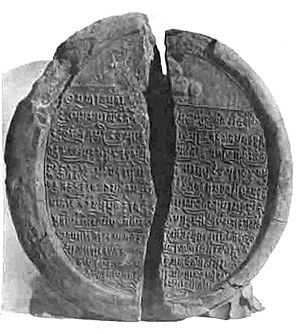
After the Gupta Empire declined, Harsha was a very important supporter of Nalanda. He was an emperor in the 7th century. Xuanzang said that Harsha built grand Buddhist monasteries and also three temples for Hindu gods.
Nalanda received gifts, including grants of villages from kings. Harsha himself gave 100 villages. He also ordered 200 families from each village to provide daily supplies like rice, butter, and milk to the monks. This supported many teachers and students at Nalanda.
Xuanzang's Visit (630–643 CE)
Xuanzang traveled around India from 630 to 643 CE. He visited Nalanda in 637 and 642, staying for about two years. He was welcomed warmly and given the Indian name Mokshadeva. He studied under Shilabhadra, the head of Nalanda at that time.
Xuanzang felt his long journey to India was worth it because he found a great teacher in Shilabhadra. Besides Buddhist studies, he took classes in grammar, logic, and Sanskrit. He also gave lectures at Nalanda.
He described the view from his room: "The whole place is surrounded by a brick wall. One gate opens into the main college. There are eight other halls in the middle. The beautiful towers and fairy-like turrets look like pointed hills. The observatories seem to disappear in the morning mist, and the upper rooms reach above the clouds."
Xuanzang returned to China with 657 Sanskrit texts and 150 relics. He carried them on 20 horses in 520 cases. He translated 74 of these texts himself.
Yijing's Visit (673–700 CE)
After Xuanzang, many other travelers from China and Korea visited Nalanda. One of them was the monk Yijing. He arrived in 673 CE and stayed in India for 14 years, with 10 of those years at Nalanda. When he went back to China in 695, he had 400 Sanskrit texts and 300 Buddha relics.
Yijing's writings mainly focus on how Buddhism was practiced in India. He described the rules and daily life of the monks at Nalanda. He noted that income from 200 villages (more than in Xuanzang's time) was used to support Nalanda. He said there were eight monasteries with about 300 rooms.
Yijing explained many daily rules for the monks. For example, the day started with a bell ringing. Monks would go to one of the ten large pools to bathe. They had specific ways to bathe and change clothes. Bathing after meals was not allowed. These detailed rules were part of the Buddhist procedures at Nalanda.
Korean and Tibetan Pilgrims
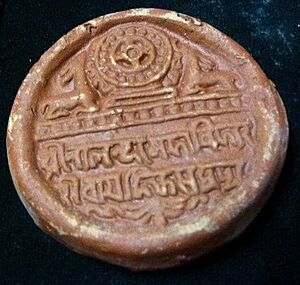
Buddhist travelers from Korea also visited India around the same time as Xuanzang and Yijing. Monks like Kyom-ik started visiting Indian monasteries in the mid-6th century. They also took Indian texts back and translated them.
In the mid-7th century, the Korean monk Hyon-jo stayed at several Indian monasteries, including three years at Nalanda. He sent his students to Nalanda to study. Korean records show that monks continued to visit India until the 9th century to study at monasteries, with Nalanda being the most respected.
From the 7th century onwards, Tibetan monks like Thonmi Sambhota came to Nalanda. They studied Buddhism, Sanskrit, grammar, and other subjects. Sambhota is known for using Sanskrit rules to improve the Tibetan language and its writing. After his first return from Nalanda, the Tibetan king adopted Buddhism.
Tibetans continued to visit Nalanda during the Pala era and even later, until the 14th century. They shared ideas at Nalanda and other monasteries. After the 8th century, a type of Buddhism called Vajrayana, which uses mandalas and deities, became more popular in these exchanges.
Pala Dynasty (750–1200 CE)
The Palas ruled eastern India from the mid-8th century to the late 12th century. They were a Buddhist dynasty. Under the Palas, the traditional Mahayana Buddhism at Nalanda changed. A newer form called Vajrayana Buddhism, which included Tantra and deities, became more common.
Nalanda still received support from the Palas. However, the Palas also built new monasteries for Vajrayana Buddhism. Some of these, like Odantapura, were very close to Nalanda. These new monasteries might have attracted some learned monks away from Nalanda.
Writings, artwork, and seals found at Nalanda show that it was still active and doing well under the Palas. Kings Dharmapala and Devapala were active supporters. Many metal statues from the 9th century mentioning Devapala have been found.
One important writing, a copper plate found at Nalanda, talks about a gift from King Balaputradeva of Sumatra. This king, who admired Nalanda, built a monastery there. He asked Devapala to give income from five villages for its upkeep, and Devapala agreed.
Another writing from Devapala's time mentions that he supported a monk named Viradeva. Viradeva had studied all the Vedas and later became the head of Nalanda.
Writings from the 9th to 12th centuries show that Nalanda continued to receive gifts. These gifts helped maintain the monastery, support the monks, and copy palm leaf manuscripts. One writing even mentions a fire that destroyed a Nalanda library and how it was later rebuilt. Another writing from the 10th century shows that different types of Buddhist schools were active at Nalanda.
The Palas supported Nalanda, and Nalanda's fame helped the Palas. The Srivijaya kingdom in Southeast Asia had direct contact with Nalanda and the Palas. This influenced art in Sumatra, Java, and other regions. Monks from Indonesia, Myanmar, and other parts of Southeast Asia came to Nalanda during the Pala rule.
Decline and Destruction (around 1200 CE)
Archaeological digs at Nalanda found a thick layer of ashes on top of many buildings. This suggests that Nalanda suffered a huge fire. It is believed that this fire was caused by the troops of Muhammad Bakhtiyar Khalji around 1200 CE. He attacked and looted the region. While some writings mistakenly link this to another monastery, Nalanda was indeed raided by Khalji.
Tibetan records also describe what happened at Nalanda in the late 12th and 13th centuries. During these decades, many monasteries in the region were destroyed. Tibetan records say that monks from Nalanda and nearby monasteries who survived "fled to Tibet."
A useful Tibetan record is the story of the monk Dharmasvamin. He met fleeing monks and famous scholars between 1200 and 1226. He visited Bihar around 1234, including staying at Nalanda for a monsoon season. He described the situation after the attacks on Nalanda and other Buddhist monasteries. His account says that the destruction was widespread and included Bodhgaya. Most of the large libraries of manuscripts were lost. Monks moved to Nepal to study and copy manuscripts to send to Tibet.
Dharmasvamin described Nalanda around 1235 CE as "largely damaged and deserted." However, some monks had gathered again and continued their studies. They received help from a rich person named Jayadeva. Dharmasvamin stated:
"There lived a respected and wise monk who was over ninety years old, the Guru and Mahapandita Rahulasribhadra. King Buddhasena of Magadha honored this Guru and four other scholars, and about seventy respected monks."
Dharmasvamin stayed there for six months. He did not mention the famous Nalanda library, which probably didn't survive the first attacks. He also said that some buildings were still standing, with "eighty small monasteries, built of bricks and many left undamaged." But "there was absolutely no one to look after them." He also described an attack on the ruined Nalanda by soldiers.
A Buddhist monk named Dhyānabhadra, born in 1289 AD, is recorded as attending Nalanda from age eight. This suggests the university continued to operate into the late 13th century.
Continued Influence
Some scholars say that Nalanda's end wasn't sudden. It continued to have some students into the 13th century. It's also not true that Buddhism completely ended in India around the 13th or 14th century.
Impact on Tibetan Buddhist Tradition
After the attacks and decline of Nalanda and other Buddhist centers in India, the memory of "Nalanda" remained very important in Tibet. The last head of Nalanda, Shakyashri Bhadra, fled to Tibet in 1204. Some of the surviving Nalanda books were taken by fleeing monks to Tibet.
In 1351, Tibetans decided to build a new monastery in Tibet. They named it the "Nalanda monastery" to honor the ancient Nalanda. This new monastery was built north of Lhasa in 1436. It is now called the Tibetan Nalanda.
Tibetan Buddhism is seen as a continuation of the Nalanda tradition. The Dalai Lama says: "Tibetan Buddhism was not invented by Tibetans. It clearly comes from the pure tradition of the Nalanda Monastery. The master Nagarjuna came from this place, as did many other important thinkers and logicians..."
The Dalai Lama considers himself a follower of the seventeen Nalanda masters.
A very old manuscript from Nalanda, dating to the late 11th century, is now kept in Tibet. It has beautiful paintings and wooden covers.
Under the British Empire (1800–1947)

After its decline, Nalanda was mostly forgotten. Then, in 1811–1812, Francis Buchanan-Hamilton surveyed the area. Locals showed him some Buddhist and Hindu statues and ruins. But he didn't realize these ruins were the famous Nalanda.
That connection was made by Major Markham Kittoe in 1847. Alexander Cunningham and the new Archaeological Survey of India (ASI) did an official survey in 1861–1862.
Systematic digging and restoration of the ruins by the ASI didn't start until 1915 and ended in 1937. These efforts included digging, observing, and cataloging discoveries. They also worked on preserving the site, like adding drainage to protect the floors.
Post-Independence (After 1947)
After India became independent, more digging and restoration happened between 1974 and 1982. In 1951, the Nava Nalanda Mahavihara ("New Nalanda Mahavihara") was founded. It's a modern center for Pali and Buddhism, inspired by the ancient university. It was started by the Government of Bihar.
On September 1, 2014, a new Nalanda University began its first school year with 15 students in nearby Rajgir. This new university aims to be like the famous ancient Nalanda. It was created by an Act of Parliament. The idea to bring back Nalanda University was supported by many Asian countries in 2007. It is now a special "Institution of National Importance" in India. A large, modern campus is being built, which will be one of the biggest in Asia.
The Mahavihara
Today, the excavated ruins of Nalanda cover about 12 hectares (30 acres). But in ancient times, Nalanda Mahavihara was much larger. It taught many subjects and attracted students and scholars from Korea, Japan, China, Tibet, Indonesia, Persia, and Turkey.
The University
At its best, the school attracted scholars and students from far away. Some traveled from Tibet, China, Korea, and Central Asia. The organized way of studying helped create large learning centers like Taxila, Nalanda, and Vikramashila. These are often called India's early universities.
Evidence also shows contact with the Shailendra dynasty of Indonesia. One of their kings built a monastery in the complex. Nalanda grew strong under the Gupta Empire in the 5th and 6th centuries. Later, it was supported by Harsha, the emperor of Kannauj.
Most of what we know about Nalanda comes from the writings of monks like Xuanzang and Yijing. They traveled to Nalanda in the 7th century CE. Many of the people Xuanzang listed as former students of Nalanda were important in developing the Mahayana philosophy.
All students at Nalanda studied Mahayana Buddhism. They also studied texts from the eighteen other Buddhist groups. Their studies also included subjects like the Vedas, logic, Sanskrit grammar, medicine, and Samkhya philosophy.
Nalanda was attacked three times but rebuilt only twice. It was looted and destroyed by an army under Bakhtiyar Khalji around 1202 CE. While some sources say it continued to work for a while after this attack, it was eventually left empty and forgotten. It was rediscovered in the 19th century.
Systematic excavations began in 1915. They uncovered eleven monasteries and six brick temples. Many sculptures, coins, seals, and writings have also been found. Many of these are now in the Nalanda Archaeological Museum. Nalanda is now a popular tourist spot and part of the Buddhist tourism route.
On November 25, 2010, the Indian government "brought back" the ancient university. They created a new and separate Nalanda University nearby.
The Library
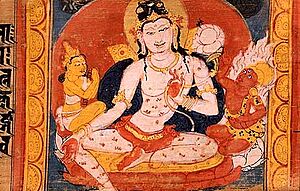
Yijing took many texts back with him after staying at Nalanda for 10 years. This shows that Nalanda must have had a very good library. Old Tibetan writings mention a great library at Nalanda called Dharmaganja (meaning "Piety Mart"). It had three large buildings with many floors. These were named Ratnasagara ("Ocean of Jewels"), Ratnodadhi ("Sea of Jewels"), and Ratnaranjaka ("Jewel-adorned").
Ratnodadhi was nine stories tall. It held the most sacred manuscripts, including the Prajnyaparamita Sutra. The exact number of books in the Nalanda library is unknown. But it's thought to have been hundreds of thousands. When a Buddhist scholar at Nalanda died, their manuscripts were added to the library.
The library collected not only religious books but also texts on subjects like grammar, logic, literature, astrology, astronomy, and medicine. The Nalanda library likely had a way to organize its books. This might have been based on a system developed by the Sanskrit linguist, Panini. Buddhist texts were probably divided into three main groups: the Vinaya, Sutra, and the Abhidhamma.
Curriculum
Xuanzang's biography says that all students at Nalanda studied the Great Vehicle (Mahayana) and the works of the eighteen other Buddhist traditions. They also studied other subjects like the Vedas, Hetuvidyā (Logic), Shabdavidya (Grammar and Language), Chikitsavidya (Medicine), and Samkhya philosophy. Vedic studies included ancient texts and rituals. They also covered related sciences like language, law, astronomy, and reasoning.
Xuanzang himself studied many of these subjects at Nalanda. Besides religious studies and philosophy, students needed to be good at Logic. This was because they had frequent debates and had to defend Buddhist ideas against other schools of thought. Other subjects taught at Nalanda included law, astronomy, and city-planning.
Tibetan tradition says there were "four ways of thinking" taught at Nalanda:
- Sarvastivada Vaibhashika
- Sarvastivada Sautrantika
- Madhyamaka, a Mahayana philosophy
- Chittamatra, another Mahayana philosophy
In the 7th century, Xuanzang recorded that there were about 1510 teachers at Nalanda. About 1000 could explain 20 collections of texts. 500 could explain 30 collections. Only 10 teachers could explain 50 collections. Xuanzang was one of the few who could explain 50 or more. At that time, only the abbot Shilabhadra had studied all the major collections of texts at Nalanda.
Administration
The Chinese monk Yijing wrote that decisions at Nalanda were made by all the monks together. If the monks had something to discuss, they would gather. Then, an officer would tell each monk about the matter. If even one monk objected, the idea would not pass. No force was used to make decisions. If there was a disagreement, they would use reasons to convince each other.
Xuanzang also noted: "The lives of all these good men were naturally guided by very strict rules. So, in the seven hundred years the monastery existed, no one ever broke the rules. The king showed his respect and gave money from a hundred cities to pay for the monks' living."
Influence on Buddhism
A lot of what became Tibetan Buddhism, both its Mahayana and Vajrayana traditions, came from the teachers and ideas at Nalanda. Shantarakshita, who helped spread Buddhism in Tibet in the 8th century, was a scholar from Nalanda. He was invited by the Tibetan king and started the monastery at Samye. He and his student Kamalashila (also from Nalanda) taught Tibetans how to think about philosophy. Padmasambhava, also invited from Nalanda in 747 CE, is seen as a founder of Tibetan Buddhism.
The scholar Dharmakirti (around 7th century), who helped start Indian philosophical logic in Buddhism, also taught at Nalanda.
Other forms of Buddhism, like Mahayana Buddhism in Vietnam, China, Korea, and Japan, also grew from the ancient school. Some scholars believe certain Mahayana texts, like the Shurangama Sutra, came from the Buddhist tradition at Nalanda.
Several Buddhist schools overseas have named themselves Nalanda to show its influence. These include Nalanda Buddhist Society in Malaysia and Nalanda College, Colombo, Sri Lanka.
World Heritage Site Recognition
The Nalanda Mahavihara was recognized as a World Heritage Site by UNESCO in 2016.
Historical Figures Associated with Nalanda
Old writings say that both Mahavira and the Buddha visited Nalanda around the 6th and 5th centuries BCE. It is also the birthplace and place of death of Shariputra, one of Buddha's famous students.
Other important people linked to Nalanda include:
- Aryadeva, a student of Nagarjuna
- Asanga, a key figure in the Yogacarya school
- Atisha, a Mahayana and Vajrayana scholar
- Chandrakirti, a student of Nagarjuna
- Dharmakirti, a logician
- Dignaga, who started Buddhist Logic
- Nagarjuna, who formalized the idea of Shunyata
- Naropa, a student and teacher
- Shantideva, who wrote the Bodhisattvacarya
- Shilabhadra, the teacher of Xuanzang
- Xuanzang, the famous Chinese Buddhist traveler
- Yijing, another Chinese Buddhist traveler
Excavated Remains
After its decline, Nalanda was mostly forgotten until the 19th century. Digging and restoration began in 1915 and continued in later years.
The remains of Nalanda today are about 488 meters (1600 feet) long from north to south and 244 meters (800 feet) wide from east to west. Digs have found eleven monasteries and six large brick temples. They are arranged in an organized way. A 30-meter (100-foot) wide path runs north to south, with temples on the west and monasteries on the east.
Most buildings show signs of being built many times. New buildings were often put on top of older ruins. Many buildings also show signs of fire damage at least once.
The map shows the layout of the excavated buildings. Temple 3 in the south was the most impressive building. Temples 12, 13, and 14 face the monasteries and face east. Most monasteries face west.
All the monasteries at Nalanda look very similar. They are rectangular with a central courtyard. This courtyard is surrounded by a verandah, which has cells for the monks. The main shrine is in the central cell facing the entrance. This design is typical for a vihara.
Monastery 1 is thought to be the oldest and most important monastery. It shows nine levels of construction. Its lower part is believed to be the one supported by Balaputradeva, the Srivijayan king, in the 9th century. The building was at least two stories high and had a huge statue of a seated Buddha.
Temple no. 3 (also called Sariputta Stupa) is the most famous building at Nalanda. It has many stairs that go all the way to the top. The temple started as a small building and was made bigger many times. The final structure was built at least seven times. The fifth layer is the most interesting and best preserved. It has four corner towers, three of which can be seen. The towers and stair sides are decorated with beautiful art from the Gupta era. These include stucco figures of Buddha and Bodhisattvas, and scenes from the Jataka tales (stories about Buddha's past lives). The temple is surrounded by many small stupas. Some of these have bricks with passages from Buddhist texts. The top of Temple no. 3 has a shrine where a huge Buddha statue once stood.
Temple no. 2 has 211 sculpted panels. These show religious figures like Shiva and Parvati, and also everyday scenes. Some scholars think Temple 2 was a Hindu temple. However, others suggest it might be a temple based on mandala principles, showing a mix of Hindu and Buddhist ideas.
The site of Temple no. 13 has a brick smelting furnace with four chambers. Burnt metal and slag found here suggest it was used to make metal objects.
North of Temple 13 are the remains of Temple no. 14. A huge image of the Buddha was found here. The base of the image has parts of the only surviving mural painting at Nalanda.
East of Temple 2 are the remains of Sarai Temple. This multi-story Buddhist temple had many stupas and shrines. It was surrounded by a large wall. The remains suggest the Buddha statue inside was about 24 meters (80 feet) high.
Many sculptures, murals, copper plates, artworks, writings, seals, coins, and pottery have been found in the ruins of Nalanda. Buddhist sculptures include those of the Buddha in different poses, Avalokiteshvara, and Tara. Hindu sculptures of Vishnu, Shiva-Parvathi, Ganesha, and Surya have also been found.
A Black Buddha temple (locals call it Telia Bhairav) is near Temple 14. It has an ancient large black Buddha image.
Surviving Nalanda Manuscripts
Monks who fled Nalanda took some manuscripts with them. A few of these have survived and are kept in places like:
- Los Angeles County Museum of Art
- Asia Society
- Yarlung Museum, Tsetang (Tibet)
Nalanda Inscriptions
Many inscriptions were found during the excavation. They are now in the Nalanda Museum. These include:
- An inscription from the 8th century CE, found in Monastery 1, about a donation to a temple.
- A 7th-century CE inscription about a large brass Buddha image.
- A late 12th-century inscription about a monk building a monastery.
- The donation of Balaputradeva, the king of Sumatra, from 860 CE. This copper plate was found in Monastery 1.
Tourism
Nalanda is a popular place for tourists in India. It's also an important stop on the Buddhist tourism circuit.
Nalanda Archaeological Museum
The Archaeological Survey of India has a museum near the ruins for visitors. The museum opened in 1917. It displays old items found at Nalanda and nearby Rajgir. Out of over 13,000 items, 349 are on display in four galleries.
Xuanzang Memorial Hall
The Xuanzang Memorial Hall was built by India and China together. It honors the famous Buddhist monk and traveler. A skull bone of Xuanzang is displayed in the hall.
Nalanda Multimedia Museum
Another museum next to the excavated site is the privately run Nalanda Multimedia Museum. It tells the history of Nalanda using 3-D animation and other multimedia shows.
Gallery
-
Ganesha, Bronze, from Nalanda, 10th century
See also
Related sites and places:
- Telhara – Telhara was the site of a Buddhist monastery in ancient India
- Bakhtiarpur – named after Bakhtiar Khilji who destroyed Nalanda Mahavira
Ancient Indian learning centers:
Others:
- Ancient higher-learning institutions
- List of Monuments of National Importance in Bihar
- Kurkihar hoard


